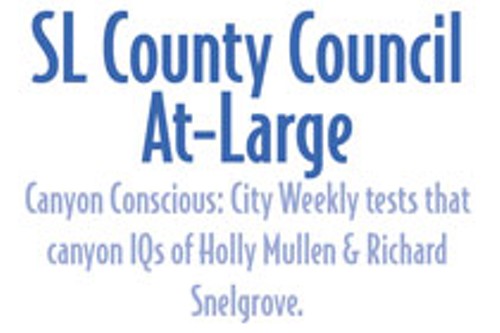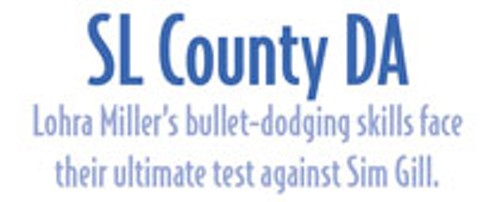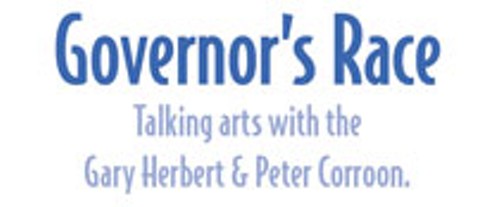Artful Dodgers: Talking arts with Utah gubernatorial candidates
Herbert, Corroon's leadership styles are reflected in their plans for arts.
By Josh LoftinEvery campaign season, certain issues dominate headlines while others are shoved to the side like Merlot wine after Sideways. In almost every race, the economy and immigration are the primary focus for voters, with the philosophical debate about ethics not far behind.
As a way to probe deeper into political platforms, City Weekly decided to approach a number of races looking at issues City Weekly readers care most about.
In the gubernatorial contest, we delved into a quality-of-life issue: funding for the arts. After all, just as a governor can directly influence the direction of the education and health-care system in the state, his support for the arts and what arts means to him can help determine whether Utah is a genuine cultural oasis and home for companies that seek to hire the “cultural creatives” seen as a boon to most economies.
In the federal races, we ask about the formerly high-profile military issues. That includes the wars in Iraq and Afghanistan, as well as domestic issues, especially veteran care.
|
|
|
|
|
|
|
|
|
|
For the Legislature, we highlighted a few races where the winners could prove strong allies for gay-rights activists. Surprisingly, they are not all Democrats. Within Salt Lake County, the two candidates vying for the at-large seat on the county council are quizzed about their positions on uses and protections for the Wasatch Mountain canyons.
Finally, consider this issue a good start. Visit CityWeekly.net throughout the week for ongoing election features.
Artful Dodgers: Talking arts with Utah gubernatorial candidates
Herbert, Corroon's leadership styles are reflected in their plans
for arts.
Alternatively, envision floating water lilies as painted by impressionist master Claude Monet, or black-and-white photographs of Zion and Yosemite National Parks as shot by Ansel Adams. These are the artists who Salt Lake County Mayor Peter Corroon names when asked for his favorites.
This year’s gubernatorial race has garnered a lot of attention, especially as Corroon has tried to make the debate about his ephemeral higher standards versus Herbert’s business-as-usual approach. Herbert, meanwhile, has focused on his accomplishments and his ability to bring divergent groups together for one of oh-so-many committees.
At the final judgment, both are professional politicians who stick to their talking points, fence with plastic swords and are individually convinced that they have The Plan while their opponent has nothing more than half-baked ideas.
Listening to both talk about the role of state government in supporting the arts, however, provides insight into their respective leadership styles.
Corroon is the pragmatist, highlighting safe, worldly artists whose calendars sell out before Christmas. He offers solutions that avoid government control of the arts but still use government influence to boost the community, such as his support of a statewide tax that is similar to Salt Lake County’s Zoo, Arts and Parks [ZAP] tax.
Herbert is proudly parochial, holding up as a state treasure a renowned LDS artist who paints idealistic scenes. He wants mostly private support for professional art, with public support geared more toward arts education during the formative years. But as with many of his talking points, he focuses on what the state has accomplished culturally and how it can improve on those successes.
According to a study by the National Assembly of State Arts Agencies, the tangible benefits of state-funded arts programs include economic boosters, improved educational performance, enhanced civic engagement and a preservation of a state’s culture. Additionally, it encourages private support and provides funding for underserved populations, such as minorities and the youth.
Yet arts funding has suffered during the recent economic downturn. In the 2011 fiscal year, which began July 1, the state appropriated $3.9 million for the arts, a reduction of 27 percent from the previous year.
Landscape Politics
My interview with Corroon is conducted in the back of Chevy sedan after a debate at Utah Valley University. Although I focus my questions on arts, Corroon keeps trying to push the conversation toward the ethical questions surrounding Herbert—that is, when he doesn’t wander into non-sequiturs, such as his recommendation that I attend “The Man Expo” [coming Nov. 12-13 at the South Towne Expo Center in Sandy].
Corroon supports a statewide arts tax, but he doesn’t think government should drive arts funding. “The community needs to fund the arts. The government can do that, to an extent. But the arts should not be reliant on government.”
As with most of his ideas, Corroon loves a plan for the arts. It’s what he did in Salt Lake County by ordering a cultural-facilities master plan, which ideally will encourage cities to work together to create a thriving cultural landscape instead of competing for the same limited dollars with identical projects. Something similar could be done at the state level that could provide a comprehensive guide to leverage the already vibrant arts community.
“We should be known as an artistic haven,” Corroon says. “It’s incredible what we have in Utah, and we need to support that. It enhances the state and impacts the quality of life.”
The government can do that with state-funded organizations such as the Utah Arts Council, as well as publicly supporting artists. For example, he points to the county’s arts collection, the largest publicly owned collection of Utah art. But government also needs to avoid too much involvement, lest it stifles the organic growth of a creative industry.
Corroon played the clarinet in high school and would love to master photography. While his time to enjoy the arts is very limited, the most recent cultural performance he attended was a performance by the Utah Chamber Artists Orchestra.
The Perfect World
Herbert’s choice of Friberg, as well as Norman Rockwell, as favorite artists says a lot about his leadership style. His choice of artists shows a yearning for the perfect, unblemished world. That’s how he’s governed, with his constant push to “bring people to the table,” and it also summarizes his campaign rhetoric that things are good and getting better.
Like Friberg, who died this summer at the age of 96 after having lived in Salt Lake City much of his life, Herbert is a hard-working perfectionist who never wants to be misinterpreted. At his core, he is a country gentlemen, the glad-handing, back-slapping good ol’ boy who paints pretty pictures for the people that are all sunlight and God, without any gritty undertones.
In my interview with him, Herbert is also the impatient leader, answering questions with sound bites and anxiously looking at his watch. I went into the interview on shaky ground, having made a joke about being tailgated by his security detail on Twitter the week prior that was not laughed about in the governor’s office. The tension was compounded by the fact that the interview was a “walk and talk” followed by a few, uncomfortable minutes in the parking lot of Salt Lake Community College.
“Promoting the arts is an important part of boosting the community,” he says almost immediately, employing a perfect political quote. “It’s quality of life, which is less tangible but a vital part of our fabric.”
Mostly, his answers about what he would do for the arts as governor swing back to his easy-to-discuss educational plan, which focuses on producing well-rounded individuals.
His perfect-world artistic taste goes beyond Friberg and Rockwell, however. When asked about the most recent artistic performances he attended, he points to the Broadway-themed Governor’s Gala and a Mormon Tabernacle Choir performance. Additionally, Herbert’s family is artistic. He plays piano and played the trumpet in his high school band. His wife, Jeannette, grew up in Springville, a renowned arts center, and she also paints. Finally, his daughter-in-law, Carmen Rasmusen, was an American Idol finalist.
Squint Harder
Out of the art galleries and into the mall. There, in the kiosk by the music store, a sullen teenager is hawking 3-D posters. Tightly squint your eyes and, eventually, the dots form a picture—or so they claim.
That’s probably the best way to look at these answers about a candidate’s support for the arts. At least with Corroon and Herbert, their answers about this one issue provided a deeper insight to who they are as politicians, executives and people—at least for me.
Both candidates, in fact, answered the questions in way that will appeal to their respective bases. Their economic philosophies, normally used to discuss business growth, remained steady when talking about supporting the arts. As with education generally, they both emphasized the need for a “well-rounded curriculum” that would lead to smarter workers and help attract companies to the state. And so forth.
Go ahead, compare their answers to questions about arts to answers about other issues. Squint ... harder. The dots will start to merge, and eventually show you the real picture of the candidates.
More by Josh Loftin
-
Smoking Help, Farm Taxes & Gallivan Skating
Apparently, Salt Lake City officials believe that a premium price is justified for a small, outdoor rink with an ambiance that includes construction noise and heavy equipment ...
- Dec 1, 2010
-
Amendment Madness, Free Legal Aid & Lobbyist Influence
U.S. Rep. Rob Bishop, R-Utah, plans to propose an amendment to the U.S. Constitution that would allow states to veto an action ...
- Nov 24, 2010
-
Anti-affirmative action, TSA Protest & Federal $$
Legislators look to stop affirmative action. Jason Chaffetz still hates body scanners, but doesn't want to protest them in airports. And Utah legislators hate federal money a little bit less after elections.
- Nov 17, 2010
- More »
Latest in Cover Story
Readers also liked…
-
Forget the family pedigree—Robert F. Kennedy Jr should not be the next president of the United States
Trojan Horse
- Jun 21, 2023
-
Women decry harassment and toxic culture at St. George auto dealership
Men at Work
- Oct 11, 2023










